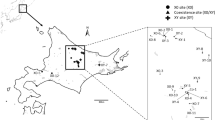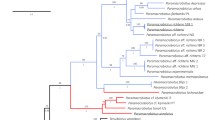Abstract
THE genus Sanguisorba L., comprising about 40 species, has been the object of several cytological and taxonomical studies during recent years. Thus we have already gained a rather good idea of the cytological pattern of this genus1,2. In particular, specimens of the form complex Sanguisorba minor, from all over its distribution area, have been studied. The species forms a polyploid series of 7. Up until now tetraploids, hexaploids and octoploids have been found, but never diploids. I have examined neighbouring monotypic genera with woody structure3,4; they too turned out to be tetraploids, namely, Bencomia caudata, Dendriopoterium menendezii, Marcetella moquiniana, and Poterium spinosum.
This is a preview of subscription content, access via your institution
Access options
Subscribe to this journal
Receive 51 print issues and online access
$199.00 per year
only $3.90 per issue
Buy this article
- Purchase on Springer Link
- Instant access to full article PDF
Prices may be subject to local taxes which are calculated during checkout
Similar content being viewed by others
References
Böcher, T. W., and Larsen, K., Bot. Tidsskr., 53, 284 (1957).
Nordborg, G., Bot. Notiser, 111, 240 (1958).
Larsen, K., Bot. Notiser, 108, 264 (1955).
Larsen, K., Bot. Notiser, 109, 296 (1956).
Sakai, K., Jap. J. Genet., 11, 68 (1935).
Hulten, E., Kungl. Svensk. Vet. Handl., III, 8, 1 (1929).
Author information
Authors and Affiliations
Rights and permissions
About this article
Cite this article
LARSEN, K. Cytology of the Genus Sanguisorba . Nature 184, 743–744 (1959). https://doi.org/10.1038/184743a0
Issue Date:
DOI: https://doi.org/10.1038/184743a0
Comments
By submitting a comment you agree to abide by our Terms and Community Guidelines. If you find something abusive or that does not comply with our terms or guidelines please flag it as inappropriate.



